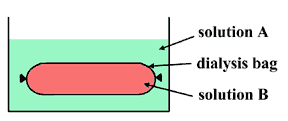
4- LETS PUT EVERYTHING TOGETHER:
We are going to make it simple. We are going to look at
the effects solutions have on the shape of a dialysis bag.

If you know how to do that, you should not have too much trouble when dealing with live systems. In live systems, the dialysis bag would be like your cells, solution B, your intracellular fluid and solution A your extracellular fluid.
To predict what is happening you have to: